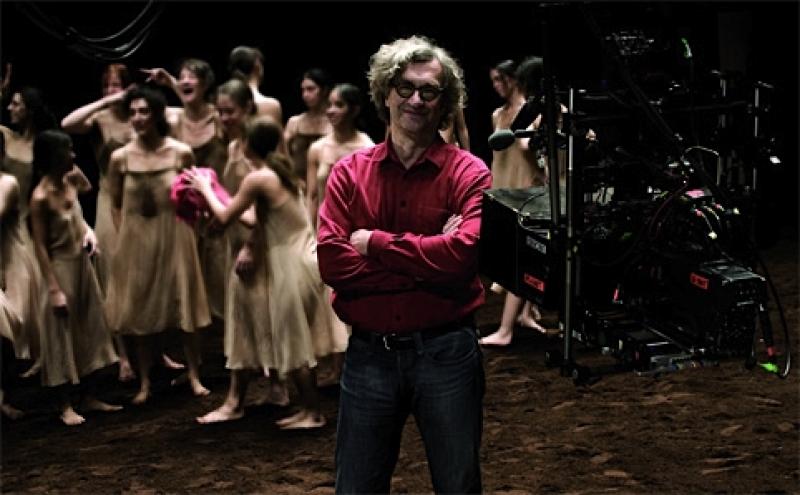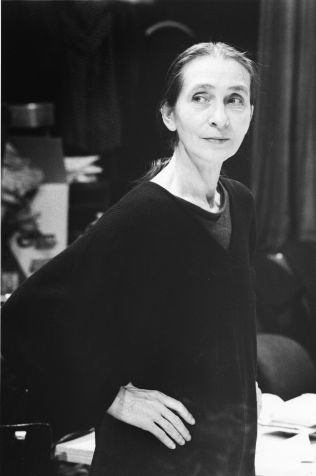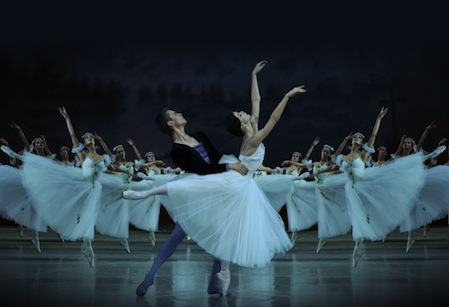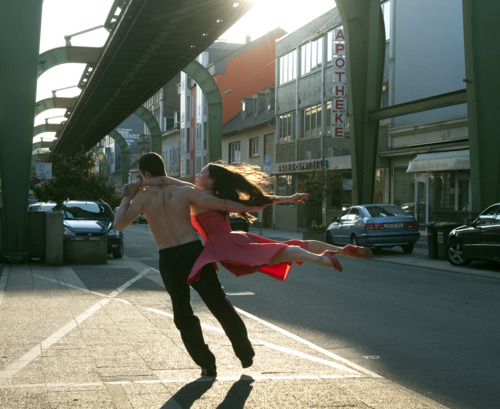Pina 3D/ Giselle 3D | reviews, news & interviews
Pina 3D/ Giselle 3D
Pina 3D/ Giselle 3D
Miraculous dance filming by Wenders, but gelatinous cult of personality spoils it

Pina Bausch decided: “Words can’t do more than just evoke things - that’s where dance comes in.” Well, up to a point, Lord Copper. Only if they’re bad words and good dance - bad writhing instead of, say, Shakespeare’s words isn’t much of a swap.
Part of it was that it was a theatrical expression of adult instincts that we all share, rather than a school of dance that you had to know standards to access. Wim Wenders was one of many people who came to Bausch's work by responding to its emotional impact, without having any idea of her very well-informed academic training with Kurt Jooss, Cecchetti ballet style and Antony Tudor. Yet the film he's made strikes me as one for devotees only, brilliant in its dance shooting, but rather underlining the self-consciously cloistered worlds of modern dance and art-house movie-making.
 Bausch absorbed the effects and emotional nuances of ballet, and its reliance upon massed effects. At her best, in works like The Rite of Spring, Café Müller, Kontakthof, Nelken, she isolated a narrative visual context - realised by brilliant collaborators - and spun nuggets of movement into momentous chorus lines, or she’d find the tiny giveaway flinch in a rebellious individual and multiply it into a formidable crowd motif of conformity. This knowing conflict is what I found so disconcerting and strong about her best work, and why the aspects of cult built around her by her dancers - and magnified by Wenders in his devoted film - is odd, alien and repellent.
Bausch absorbed the effects and emotional nuances of ballet, and its reliance upon massed effects. At her best, in works like The Rite of Spring, Café Müller, Kontakthof, Nelken, she isolated a narrative visual context - realised by brilliant collaborators - and spun nuggets of movement into momentous chorus lines, or she’d find the tiny giveaway flinch in a rebellious individual and multiply it into a formidable crowd motif of conformity. This knowing conflict is what I found so disconcerting and strong about her best work, and why the aspects of cult built around her by her dancers - and magnified by Wenders in his devoted film - is odd, alien and repellent.
Whether this says more about her or her dancers and followers is hard to tell. I met her, and don’t remember a would-be cult leader. I found a shy person who’d grown up with a feeling of being unnoticed, spare, in an unstable world, a quality that she used to develop a phenomenal watchfulness. (Bausch pictured right by Wilfried Krüger). She chose to be a theatrical director of body language, rather than a writer of dance as dance, and she expected her dancers to expose every last bit of their psyche for her to pick, shape and edit.
She also understood better than any other choreographer I've seen the power of ritual in joyfulness and in horror. She enjoyed the sexuality in violence, she enjoyed the comedy in discordant behaviour, she exploited with great intelligence the erotic need for sadism and masochism in many relationships, and she also loved the gorgeously sad visions of romantic ballet, the otherworldliness of which seems to me to infuse so much of her treatment of her female characters. Her imaginative and editing pencil was sharpened to a very fine point, and it's easy to see why she was a personal magnet. But it's a rather tragic revelation to be shown in this film how dependent upon her so many of her dancers were.
Watch the film's trailer
Wenders explains elsewhere on theartsdesk how he swiftly formed a shared aim with Bausch to shoot her work in performance in 3D. She died suddenly in 2009 as the project was in its early stages. The film that he resumed work on has changed drastically, of course, from the originally envisaged one. It has become a self-conscious epitaph, a formally structured memorial service, with her danceworks, her dancers’ mourning, and Wenders’ own desire to create elegiac content for the film jostling in a three-way weave.
Only the dance shooting is, to my mind, what makes Pina 3D worth seeing twice and three times. Wenders has with masterly skill applied the flighty marvel of 3D to two of Bausch’s most unforgettable works, her Rite of Spring and Café Müller. His jump-cuts between old 2D film and new 3D re-shoots show how entirely different the atmospheres of each are, how differently you read them. For the experience that he offers in recording large chunks of those two works, see this film - this really does bring the third dimension of experience excitingly to your attention.
 Watching the Mariinsky’s cumbersome recent effort at Giselle in 3D, screened last month around Britain, or the hectic, over-busy mess that was the technique adopted for StreetDance 3D last year, indicated that 3D is far from a simple shooting technique to master in dance. The Russian Giselle died on the screen from its almost comically static cameras, making the principal dancers as dissociated from their scenic context as cartoons animated on a flat painting. The astonishment that is Natalia Osipova’s performance as Giselle (pictured with Leonid Sarafanov and the Mariinsky corps de ballet) is diminished by the clumsiness of the direction, and ironically a 2D version of this stellar cast would be vastly more cherishable as well as accessible.
Watching the Mariinsky’s cumbersome recent effort at Giselle in 3D, screened last month around Britain, or the hectic, over-busy mess that was the technique adopted for StreetDance 3D last year, indicated that 3D is far from a simple shooting technique to master in dance. The Russian Giselle died on the screen from its almost comically static cameras, making the principal dancers as dissociated from their scenic context as cartoons animated on a flat painting. The astonishment that is Natalia Osipova’s performance as Giselle (pictured with Leonid Sarafanov and the Mariinsky corps de ballet) is diminished by the clumsiness of the direction, and ironically a 2D version of this stellar cast would be vastly more cherishable as well as accessible.
Wenders understood - as only a contemplative film-maker perhaps would - that what 3D should do is give the space a palpable physical presence, so that the significance of the way movement cuts it becomes apparent and thrilling in a dimensional immediacy that you can’t even get when sitting in the front row of the stalls at a live show. Choreography means "space-writing", arranging dances in stage space, not actually the art of phrasing steps. And Wenders is the first 3D film-maker I’ve seen who absolutely gets that.
He uses the travelling cameras and oblique angles to search out not dancers (which 2D cameras do) but to explore the space between them. You can feel, touch, breathe the space inside the Rite of Spring, it is phenomenally rewarding to sense this. As the girls try to escape being fingered, the boys pursuing in packs, you fly like an invisible ghost through their lethal conflict, uninvolved in it yet able to be inside all of it, the ultimate irresponsibility. This is fascinating stuff, as if 3D makes the viewer no longer a supplicant in the theatrical experience but a god, removed and above it.
 The two other ingredients that he mixes in are by contrast weirdly artificial in feeling. He naffly stages dancers in Bausch-ian encounters outdoors in their utilitarian home town of Wuppertal - a woman in a satin ballgown at a traffic junction, an old man in a sylphide ballet dress in a mine shaft, a conga of dancers doing one of Bausch’s famous tic-tac gesture sequences on sand dunes. These echo of Bausch, and sure they're camera-friendly, but it's because Bausch brought seashores and sand dunes inside the theatre that frolics in water or sand were wonderfully mad and dislocating. Back out in the natural world, the 3D loses effect and the dancers look as if they're making trendy fashion commercials.
The two other ingredients that he mixes in are by contrast weirdly artificial in feeling. He naffly stages dancers in Bausch-ian encounters outdoors in their utilitarian home town of Wuppertal - a woman in a satin ballgown at a traffic junction, an old man in a sylphide ballet dress in a mine shaft, a conga of dancers doing one of Bausch’s famous tic-tac gesture sequences on sand dunes. These echo of Bausch, and sure they're camera-friendly, but it's because Bausch brought seashores and sand dunes inside the theatre that frolics in water or sand were wonderfully mad and dislocating. Back out in the natural world, the 3D loses effect and the dancers look as if they're making trendy fashion commercials.
More troublesome is the dutiful procession of bereaved dancers before the camera, gazing mutely at the lens while their voices are heard in occasionally insightful but mostly piteous statements about Bausch’s place in their lives. They feed off every remembered word from her. They wish they dreamed about her. Some of them seem to have died with their leader. Did Bausch herself foster this kind of slavishness in her dancers? If so, the company isn't going to long survive her death.
The other question is whether, honestly, achieving 3D dance shooting of this calibre isn't just too elite a pursuit to establish dance's presence in cinemas. It's clear from the glorious best in this film that 3D and dance performance could have a fabulous relationship and crack open the public's access to enjoying the complex beauties of choreography. But given that I'd not get out of bed for any of the 3D dance I've seen before this one, and there aren't a lot of Wenders out there, I'm not going to put money on it happening.
- Pina 3D goes on release this week
- Read the Q&A Special with director Wim Wenders on theartsdesk
Watch a trailer about the making of the film
Watch Pina Bausch performing in the 1985 TV version of Café Müller
Add comment
The future of Arts Journalism
You can stop theartsdesk.com closing!
We urgently need financing to survive. Our fundraising drive has thus far raised £49,000 but we need to reach £100,000 or we will be forced to close. Please contribute here: https://gofund.me/c3f6033d
And if you can forward this information to anyone who might assist, we’d be grateful.

Subscribe to theartsdesk.com
Thank you for continuing to read our work on theartsdesk.com. For unlimited access to every article in its entirety, including our archive of more than 15,000 pieces, we're asking for £5 per month or £40 per year. We feel it's a very good deal, and hope you do too.
To take a subscription now simply click here.
And if you're looking for that extra gift for a friend or family member, why not treat them to a theartsdesk.com gift subscription?

Comments
...